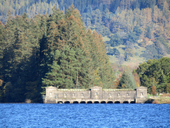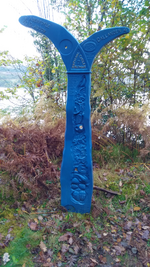a page from an album inscribed in the frontispage "F W Staines 3 Uplands St Leonards on Sea"
Amelia Jackson, Nee Staines (1842 – 1925) and thence by descent
Loch Venachar is a freshwater loch in Stirling district, Scotland.

The loch is situated between Callander and Brig o' Turk. It lies approximately 82 metres (269 ft) above sea level, and is 6 kilometres (3.7 mi) long with a maximum depth of approximately 33 metres (108 ft).
The Black Water discharges from Loch Achray into the western end of Loch Venachar, and at the eastern end emerges the Eas Gobhain which joins with the Garbh Uisge (River Leny) at Callander to form the River Teith. A small dam, which controls the water level, was built in the 19th century by John F. Bateman and is now a Listed building.
An island in the loch, Portnellan island, is an Iron Age crannog and has been designated as a Scheduled Ancient Monument.
The south shore of the loch is covered by woodland containing numerous forest tracks, some leading over the hills to the Lake of Menteith and some leading westward along the loch to Loch Achray and the Trossachs. Invertrossachs House, which was visited by Queen Victoria in 1869, is also located on the south shore.

Venachar sailing club is accessible from the Invertrossachs private road. This sailing club uses the loch for regular racing events between March and October. To the North of the loch is Ben Ledi, which at 879 metres (2,884 ft) is classified as a Corbett.
A brown trout stocking programme recommenced in 2016 under the management of the Loch Venachar Association and the loch also has stocks of pike, salmon, sea trout and perch. Fishing is available, by permit, from the shore and by boat.
Francis William Staines was the last of a family of merchants from the City of London. Not only was he a successful businessman but he possessed a large independent fortune, such that he could devote his time to the cultivation of his talents in music and art. He was a brilliant amateur violinist, and also loved to spend much of his time painting. His daughter Amelia and her mother accompanied Mr Staines as he travelled throughout the country finding subjects for his painting. One area of the country that they visited frequently was Scotland and the Lake District, and Amelia grew particularly fond of the dramatic landscape of the Fells. Skelwith Bridge with the view of the hills around it 43 was one of her father’s favourite scenes. He painted landscapes and maritime paintings , exhibited 11 works at the RA including views on the Italian Coast, address in London, Hastings and St Leonards on Sea Susssex.

